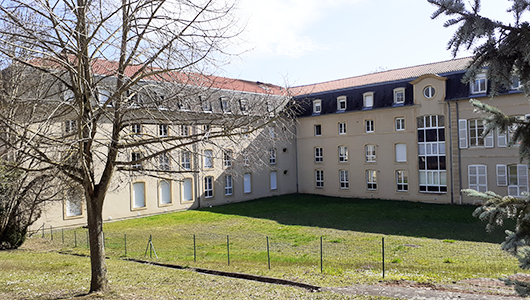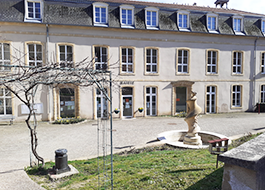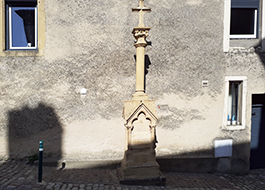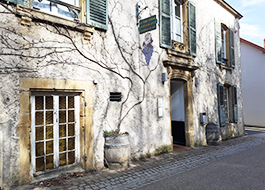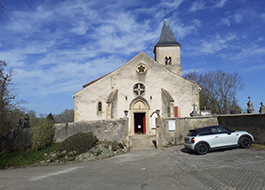Plappeville
Durée visite : 50 min
Moyen : pédestre
Son nom vient de saint Pappole, 28e évêque de Metz, qui y édifia sa résidence au VIIe siècle. D’autres villas l’avaient précédée sur les pentes du Saint-Quentin. Des reliques de ce dernier sont ramenées là en 835. Les moines de Saint-Symphorien construisent une chapelle abritant les reliques de Sainte-Brigide de Kildare, toujours patronne de la paroisse. Au 17e siècle, le chroniqueur Jean Bauchez relate les événements du village. Vers 1590, en pleine guerre de religion, 30 habitants sur 300 environ sont brûlés pour sorcellerie. La vigne est l’activité de 90% des Plappevillois. Des notables messins y résident, notamment l’été, fuyant les miasmes de Metz ou les épidémies. La guerre est un fléau bien présent: chevaliers-brigands au 14e, conflit messino-lorrain au 15e, siège de Metz en 1552, guerre de Trente ans au 17e, siège le Metz par les Russes en 1814. En 1870, lors de la bataille de Saint-Privat, Bazaine établit ici son quartier général. Par la suite, les allemands reconstruisent le fort soufflé par une explosion. Des notables allemands élisent, eux aussi, leur villégiature à Plappeville ;parmi eux, le Generalfeldmarshall von Haeseler chef du 16e corps d’armée stationné à Metz. La seconde annexion vit 95% de la population expulsée de Pleppweiler. En septembre 1944, les forts Saint-Quentin et Plappeville résistèrent longtemps aux américains. Au XXe siècle, la commune hébergea Albert Thiam auteur de tableaux de marqueterie en relief, de sculptures et autres faïences.
Its name comes from Saint Pappole, 28th bishop of Metz, who built his residence there in the 7th century. Other villas had preceded it on the slopes of Saint-Quentin. Relics of the latter saint were brought back there in 835. The monks of Saint-Symphorien built a chapel housing the relics of Sainte-Brigide de Kildare, still patron of the parish. In the 17th century, the chronicler Jean Bauchez recounts the events of the village. Around 1590, in the midst of the religious war, around 30 out of 300 inhabitants were burnt for witchcraft. The vine is the activity of 90% of Plappevillois. Notables from Metz reside there, especially in summer, fleeing the miasma of Metz or epidemics. War is a very present scourge: knights-brigands in the 14th, Messino-Lorraine conflict in the 15th, siege of Metz in 1552, Thirty Years’ War in the 17th, siege of Metz by the Russians in 1814. In 1870, during the battle of Saint-Privat, Bazaine established his headquarters here. Subsequently, the Germans rebuilt the fort blown by an explosion. German notables also elect their holiday resort in Plappeville; among them, Generalfeldmarshall von Haeseler, head of the 16th army corps stationed in Metz. The second annexation saw 95% of the population expelled from Pleppweiler. In September 1944, forts Saint-Quentin and Plappeville resisted the Americans for a long time. In the twentieth century, the town hosted Albert Thiam, author of relief marquetry paintings, sculptures and other earthenware.
Sein Name stammt von Saint Pappole, dem 28. Bischof von Metz, der dort im 7. Jahrhundert seine Residenz errichtete. Andere Villen waren ihm an den Hängen von Saint-Quentin vorausgegangen. Relikte des letzteren Heiligen wurden 835 dorthin zurückgebracht. Die Mönche von Saint-Symphorien bauten eine Kapelle, in der die Reliquien von Sainte-Brigide de Kildare untergebracht waren, die noch immer Patronin der Gemeinde ist. Im 17. Jahrhundert erzählt der Chronist Jean Bauchez von den Ereignissen des Dorfes. Um 1590, mitten im Religionskrieg, wurden rund 30 von 300 Einwohnern wegen Hexerei verbrannt. Die Rebe ist die Aktivität von 90% der Plappevillois. Vor allem im Sommer leben dort Persönlichkeiten aus Metz, die vor dem Miasma von Metz oder Epidemien fliehen. Krieg ist eine sehr gegenwärtige Geißel: Ritter-Räuber im 14., Messino-Lothringen-Konflikt im 15., Belagerung von Metz im Jahre 1552, Dreißigjähriger Krieg im 17., Belagerung von Metz durch die Russen im Jahre 1814. Im Jahr 1870, während der Schlacht von Saint-Privat, richtete Bazaine hier sein Hauptquartier ein. Anschließend bauten die Deutschen das durch eine Explosion zerstörte Fort wieder auf. Deutsche Persönlichkeiten wählen auch ihren Ferienort in Plappeville, darunter Generalfeldmarshall von Haeseler, Chef des in Metz stationierten 16. Armeekorps. Bei der zweiten Annexion wurden 95% der Bevölkerung aus Pleppweiler ausgewiesen. Im September 1944 widerstanden die Forts Saint-Quentin und Plappeville den Amerikanern lange Zeit. Im 20. Jahrhundert war die Stadt Gastgeber von Albert Thiam, Autor von Relief-Intarsiengemälden, Skulpturen und anderem Steingut.

De gueules à la crosse d’or en pal. accostée de six langues de feu du même, brochant sur la septième, à l’oiseau d’argent en pointe brochant sur la crosse.
La crosse et l’oiseau symbolisent l’abbaye de Saint-Symphorien à laquelle appartenait la seigneurie de Plappeville; les langues de feu sont l’embème de Sainte Brigitte, patronne de la paroisse.
Gules a gold crosse in pale. accosted of six tongues of fire of the same, debruising on the seventh, to the silver bird in point debruising on the butt.
The crook and the bird symbolize the abbey of Saint-Symphorien to which the seigneury of Plappeville belonged; the tongues of fire are the emblem of Saint Brigitte, patron saint of the parish.
Gules ein goldener Kreuz blass. sechs silberne Feuerzungen desselben, die am siebten zum silbernen Vogel punktierten, der auf dem Hintern debruiert.
Der Gauner und der Vogel symbolisieren die Abtei von Saint-Symphorien, zu der das Seigneury von Plappeville gehörte; Die Zungen des Feuers sind das Wahrzeichen der Heiligen Brigitte, der Schutzpatronin der Gemeinde.

Les habitants et les habitantes de Plappeville s’appellent les Plappevillois et les Plappevilloises.
The inhabitants of Plappeville are called the Plappevillois and the Plappevilloises.
Die Einwohner von Plappeville heißen Plappevillois und Plappevilloises.
Les points de visites
Château de Tignomont.
C’est en fait la maison du chapitre de la cathédrale. Il possédait quelques biens à Plappeville. Dans le jardin de cette maison, les chanoines avaient établi un ossuaire. Datant de la fin du XVIe siècle, ce bâtiment est doté d’une tour, identique à celles des résidences messines contemporaines. Il a été restauré à plusieurs reprises. Tignomont vient du latin tigneri, charpentiers. Ces derniers étaient établis prés de leur matière première, les chênes du mont.
Maison d’Arros.
Sa date de construction est inconnue. En 1775, elle est possession du comte d’Arros. Le 16 août 1870 Bazaine, fils d’un natif de Scy-Chazelles, y établit son quartier général lors de la bataille de Saint-Privat. Il fit preuve de sa pusillanimité habituelle. En 1896, les religieuses du pauvre Enfant Jésus y créent un orphelinat. Il ne fermera qu’en 1981. En 1995, la mairie s’installe ici. La fontaine toute proche a été réalisée par André Forfert en 1996. Elle symbolise la vis du pressoir et l’oiseau de l’abbaye de Saint-Symphorien.
Lavoir du haut.
Ce lavoir date de 1838. L’abbé Schmidt a cédé le terrain gratuitement. Des règles strictes régissaient son utilisation. Il était défendu d’étendre son linge sur les haies environnantes. C’était un lieu de rencontre. On y échangeait des informations vraies ou fausses. C’était un réseau social bien avant la naissance de Mark Zukerberg.
Tignomont castle.
It is actually the home of the cathedral chapter. He owned some property in Plappeville. In the garden of this house, the canons had established an ossuary. Dating from the end of the 16th century, this building has a tower, identical to those of contemporary Metz residences. It has been restored several times. Tignomont comes from the Latin tigneri, carpenters. These were established near their raw material, the oaks of Mont.
Arros House.
Its date of construction is unknown. In 1775, it was owned by the Count of Arros. On August 16, 1870 Bazaine, son of a native of Scy-Chazelles, established his headquarters there during the battle of Saint-Privat. He showed his usual cowardice. In 1896, the nuns of poor Child Jesus created an orphanage there. It will not close until 1981. In 1995, the town hall moved here. The nearby fountain was created by André Forfert in 1996. It symbolizes the screw of the press and the bird of the abbey of Saint-Symphorien.
Upper washhouse.
This washhouse dates from 1838. Father Schmidt gave up the land for free. Strict rules governed its use. It was forbidden to hang out clothes on the surrounding hedges. It was a meeting place. True or false information was exchanged there. It was a social network long before Mark Zukerberg was born.
Schloss Tignomont.
Es ist eigentlich die Heimat des Domkapitels. Er besaß ein Grundstück in Plappeville. Im Garten dieses Hauses hatten die Kanoniker ein Beinhaus eingerichtet. Dieses Gebäude stammt aus dem Ende des 16. Jahrhunderts und hat einen Turm, der mit dem der heutigen Metz-Residenzen identisch ist. Es wurde mehrmals restauriert. Tignomont stammt aus dem lateinischen tigneri, Tischler. Diese wurden in der Nähe ihres Rohstoffs, den Eichen des Berges, errichtet.
Arros Haus.
Das Datum des Baus ist unbekannt. Im Jahr 1775 war es im Besitz des Grafen von Arros. Am 16. August 1870 richtete Bazaine, Sohn eines aus Scy-Chazelles stammenden Mannes, dort während der Schlacht von Saint-Privat sein Hauptquartier ein. Er zeigte seine übliche Feigheit. 1896 gründeten die Nonnen des armen Jesuskindes dort ein Waisenhaus. Es wird erst 1981 geschlossen. 1995 zog das Rathaus hierher. Der nahe gelegene Brunnen wurde 1996 von André Forfert geschaffen. Er symbolisiert die Schraube der Presse und den Vogel der Abtei Saint-Symphorien.
Oberes Waschhaus.
Dieses Waschhaus stammt aus dem Jahr 1838. Pater Schmidt gab das Land kostenlos auf. Strenge Regeln regelten seine Verwendung. Es war verboten, Kleidung an den umliegenden Hecken aufzuhängen.Es war ein Treffpunkt. Dort wurden wahre oder falsche Informationen ausgetauscht. Es war ein soziales Netzwerk, lange bevor Mark Zukerberg geboren wurde.
.
C’est le seul vestige des débuts du protestantisme à Metz. C’est la maison de campagne du pasteur Paul Ferry (1591-1669) Celui-ci, habitant rue de la Chèvre prés du temple réformé, venait s’y reposer. Son toit est à croupe. Deux belles cheminées des XVIe et XVIIIe sont présentes à l’intérieur. Fils d’un maître échevin messin, Paul Ferry étudie à La Rochelle et à Mantauban. Il est nommé pasteur dés 1612. Il le restera jusqu’à 1669. A l’époque entre 25 et 50% des messins sont de culte protestant sur 20000 habitants. Il est au centre des controverses avec les catholiques locaux, notamment les jésuites qui récupèrent le temple. En 1631, il harangue Louis XIII et Richelieu eux-mêmes. Il entretient une dispute théologique pleine de respect mutuel avec Bossuet, alors chanoine de la cathédrale de Metz.Son œuvre écrite est considérable. Il y essaie de réfuter les thèses de ses adversaires ; et tente de réconcilier luthériens et calvinistes. Marié deux fois, il aura 12 enfants dont 2 lui survivront.
It is the only vestige of the beginnings of Protestantism in Metz. It is the country house of Pastor Paul Ferry (1591-1669) The latter, living in rue de la Chèvre near the Reformed temple, came to rest there. Its roof is hipped. Two beautiful 16th and 18th century fireplaces are present inside. Son of a master alderman in Metz, Paul Ferry studied in La Rochelle and Mantauban. He was appointed pastor from 1612. He remained so until 1669. At the time between 25 and 50% of Metz were of Protestant worship out of 20,000 inhabitants. He is at the center of controversies with local Catholics, especially the Jesuits who reclaim the temple. In 1631, he harangued Louis XIII and Richelieu themselves. He maintains a theological dispute full of mutual respect with Bossuet, then canon of the cathedral of Metz. His written work is considerable. There he tries to refute the theses of his adversaries; and tries to reconcile Lutherans and Calvinists. Married twice, he will have 12 children, 2 of whom will survive him.
Es ist das einzige Überbleibsel der Anfänge des Protestantismus in Metz. Es ist das Landhaus von Pastor Paul Ferry (1591-1669). Letzterer, der in der Rue de la Chèvre in der Nähe des reformierten Tempels lebte, kam dort zur Ruhe. Das Dach ist hüpfend. Im Inneren befinden sich zwei wunderschöne Kamine aus dem 16. und 18. Jahrhundert. Paul Ferry, Sohn eines Alderman-Meisters in Metz, studierte in La Rochelle und Mantauban. Er wurde ab 1612 zum Pastor ernannt. Er blieb es bis 1669. Zu dieser Zeit waren zwischen 25 und 50% von Metz von 20.000 Einwohnern protestantisch verehrt. Er steht im Zentrum von Kontroversen mit örtlichen Katholiken, insbesondere den Jesuiten, die den Tempel zurückerobern. 1631 sprach er Ludwig XIII. Und Richelieu selbst an. Er unterhält einen theologischen Streit voller gegenseitigen Respekt mit Bossuet, dem damaligen Kanoniker der Kathedrale von Metz. Seine schriftlichen Arbeiten sind beachtlich. Dort versucht er, die Thesen seiner Gegner zu widerlegen; und versucht, Lutheraner und Calvinisten zu versöhnen. Er ist zweimal verheiratet und wird 12 Kinder haben, von denen 2 ihn überleben werden.
.
Le pèlerinage à Jérusalem en 1860 de l’abbé Pierre, chanoine de la cathédrale de Metz, lui donne l’idée d’un chemin de croix, semblable à celui de la Ville sainte. Béni en 1866, le chemin va de la sortie du village jusqu’à l’église Saint-Quentin, au sommet du mont. La construction des forts entraîne vite sa destruction. La Croix de Jérusalem est récupérée. Déplacée plusieurs fois, elle est installée ici par la commune en 1989.
The pilgrimage to Jerusalem in 1860 by Abbé Pierre, canon of Metz Cathedral, gave him the idea of a Stations of the Cross, similar to that of the Holy City. Blessed in 1866, the path goes from the exit of the village to the Saint-Quentin church, at the top of Mt. The construction of forts quickly leads to its destruction. The Jerusalem Cross is recovered. Relocated several times, it was installed here by the town in 1989.
Die Pilgerreise nach Jerusalem im Jahr 1860 durch Abbé Pierre, Kanoniker der Kathedrale von Metz, brachte ihn auf die Idee eines Kreuzweges, ähnlich dem der Heiligen Stadt. Der 1866 gesegnete Weg führt vom Ausgang des Dorfes zur Saint-Quentin-Kirche auf dem Gipfel des Berges. Der Bau von Forts führt schnell zu seiner Zerstörung. Das Jerusalemkreuz wird geborgen. Mehrmals umgezogen, wurde es 1989 von der Stadt hier installiert.
.
Dans le Pays messin, la tradition viticole est très ancienne et remonte à l’époque gallo-romaine. La vigne se développe et finit par recouvrir les pentes du Mont St Quentin. En 1848, elle couvre plus d’un tiers du territoire de la commune. Cette tradition explique la présence de nombreuses maisons vigneronnes dans le village.Au 1, rue Paul Ferry, la présence d’une effigie de Bacchus, Dieu du vin, exprimant sa joie souligne l’ancienne activité du village : il est figuré ici sous l’aspect d’un homme barbu, dans la force de l’âge, au front couronné de lierre. Il est accompagné, en symétrie, d’un portrait de femme surmonté d’attributs floraux : la déesse des moissons, Xérès.
In the Metz region, the wine tradition is very old and dates back to Gallo-Roman times. The vine grows and ends up covering the slopes of Mont St Quentin. In 1848, it covered more than a third of the territory of the municipality. This tradition explains the presence of many winegrowers’ houses in the village.At 1, rue Paul Ferry, the presence of an effigy of Bacchus, God of wine, expressing his joy underlines the old activity of the village: he is shown here under the appearance of a bearded man, in the prime of life, with an ivy-crowned forehead. It is accompanied, in symmetry, by a portrait of a woman surmounted by floral attributes: the harvest goddess, Xeres.
In der Region Metz ist die Weintradition sehr alt und reicht bis in die gallo-römische Zeit zurück. Die Rebe wächst und bedeckt die Hänge des Mont St Quentin. Im Jahr 1848 umfasste es mehr als ein Drittel des Territoriums der Gemeinde. Diese Tradition erklärt die Anwesenheit vieler Winzerhäuser im Dorf. In 1, Rue Paul Ferry, unterstreicht die Anwesenheit eines Bildnisses von Bacchus, dem Gott des Weins, der seine Freude zum Ausdruck bringt, die alte Aktivität des Dorfes: Er wird hier unter dem gezeigt Aussehen eines bärtigen Mannes in der Blüte seines Lebens mit einer von Efeu gekrönten Stirn.Es wird symmetrisch von einem Porträt einer Frau begleitet, die von floralen Attributen überragt wird: der Erntegöttin Xeres.
C’est en 923 que les moines de Saint-Symphorien fondent un oratoire à Plappeville. Il abrite dés lors les reliques de sainte Brigide. Saint-Quentin était l’église-mère du Mont. Il reste quelques traces de l’époque romane :une fenêtre et une rosace sur la façade, deux colonnes à l’intérieur. De puissants contreforts maintiennent les murs. Le clocher-donjon date du XIe siècle. Des crochets de fer y sont fixés. Ils servaient à recevoir des volets en bois mobiles ; ils protégeaient des tirs des assaillants. Des corbeaux de bretèches sont encore discernables au-dessus de l’entrée. Détruite en 1444, l’église est reconstruite rapidement. Le portail est doté d’un tympan peu décoré. Les voussures sont sculptés de raisins et des glands de chênes. Ceux-ci sont picorés par des oiseaux. Des fenêtres sont de style gothique. Comme il était de mise au Moyen Âge, les murs étaient peints. En novembre 1944 un obus et, en 1973 un incendie ravagent l’édifice. Alain Thiam, artiste local du XXe siècle, réalise le chemin de croix. Les vitraux sont l’œuvre de Schoengauer au XIVe, de Laurent Maréchal au XIXe, de Camille Hilaire au XXe siècle. L’orgue de 1965 signé Hugo Mayer a été détruit dans un incendie criminel en 2018. Il a été remplacé fin 2020, à la grande joie des paroissiens et des mélomanes. Sainte-Brigide a vécu de 453 à 523 en Irlande. Fondatrice d’une communauté à Killdare, elle est fêtée le 1er février. A cette date, des paysans venaient faire toucher sa statue à Plappeville par des poignées d’herbes. Ces plantes étaient ensuite préparées pour être consommer. Elles préservaient des maladies et du mauvais esprit.
It was in 923 that the monks of Saint-Symphorien founded an oratory in Plappeville. It now houses the relics of Saint Brigide. Saint-Quentin was the mother church of Mont. Some traces of the Romanesque period remain: a window and a rose window on the facade, two columns inside. Powerful buttresses maintain the walls. The bell tower dates from the 11th century. Iron hooks are attached to it. They were used to receive movable wooden shutters; they protected from the fire of the attackers. Bretèche crows can still be seen above the entrance. Destroyed in 1444, the church was quickly rebuilt. The portal has a sparsely decorated tympanum. The arches are carved from grapes and acorns from oaks. These are pecked by birds. Windows are in Gothic style. As was customary in the Middle Ages, the walls were painted. In November 1944 a shell and, in 1973, a fire ravaged the building. Alain Thiam, local artist of the 20th century, creates the Stations of the Cross. The stained glass windows are the work of Schoengauer in the 14th century, Laurent Maréchal in the 19th century, Camille Hilaire in the 20th century. The 1965 organ signed Hugo Mayer was destroyed in an arson in 2018. It was replaced at the end of 2020, to the delight of parishioners and music lovers. Sainte-Brigide lived from 453 to 523 in Ireland. Founder of a community in Killdare, she is celebrated on February 1st. On this date, peasants came to have his statue touched in Plappeville with handfuls of herbs. These plants were then prepared for consumption. They preserved illnesses and evil spirits.
923 gründeten die Mönche von Saint-Symphorien in Plappeville ein Oratorium. Es beherbergt heute die Reliquien von Saint Brigide. Saint-Quentin war die Mutterkirche von Mont. Einige Spuren der Romanik sind erhalten: ein Fenster und ein Rosettenfenster an der Fassade, zwei Säulen im Inneren. Kraftvolle Strebepfeiler erhalten die Wände. Der Glockenturm stammt aus dem 11. Jahrhundert. Daran sind Eisenhaken befestigt. Sie wurden verwendet, um bewegliche Holzläden zu erhalten; Sie schützten vor dem Feuer der Angreifer. Über dem Eingang sind noch Bretèche-Krähen zu sehen. 1444 zerstört, wurde die Kirche schnell wieder aufgebaut. Das Portal hat ein spärlich verziertes Tympanon. Die Bögen sind aus Trauben und Eicheln aus Eichen geschnitzt. Diese werden von Vögeln gepickt. Fenster sind im gotischen Stil. Wie im Mittelalter üblich, wurden die Wände gestrichen. Im November 1944 verwüstete eine Granate und 1973 ein Feuer das Gebäude. Alain Thiam, lokaler Künstler des 20. Jahrhunderts, kreiert die Kreuzwegstationen. Die Buntglasfenster stammen von Schoengauer aus dem 14. Jahrhundert, Laurent Maréchal aus dem 19. Jahrhundert und Camille Hilaire aus dem 20. Jahrhundert. Die 1965 von Hugo Mayer signierte Orgel wurde 2018 bei einer Brandstiftung zerstört. Sie wurde Ende 2020 zur Freude der Gemeindemitglieder und Musikliebhaber ersetzt. Sainte-Brigide lebte von 453 bis 523 in Irland. Sie ist Gründerin einer Gemeinde in Killdare und wird am 1. Februar gefeiert. An diesem Tag kamen Bauern, um seine Statue in Plappeville mit Handvoll Kräutern berühren zu lassen. Diese Pflanzen wurden dann zum Verzehr vorbereitet. Sie haben Krankheiten und böse Geister bewahrt.

